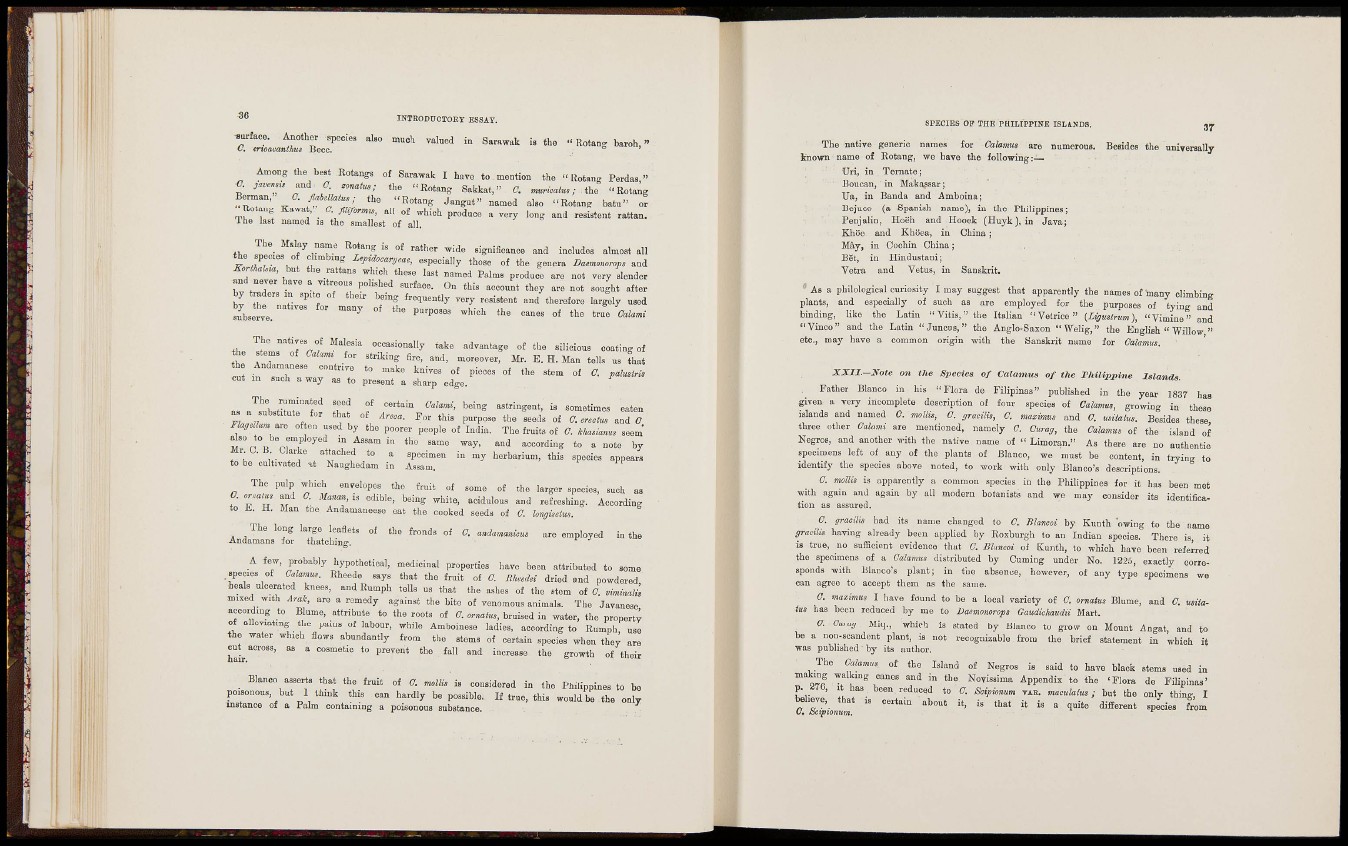
M
surface. Another species
C. erioacanihm Becc.
IHTEODDOTOET ESSAY,
muoh valuBd in Sarawik is the " Rotang baroh, "
Among the best Rotangs of Sarawak I haTe to mention the " Rotang Perdas,"
K J»™., and a. the "Kolang Sakkat," ft the "Kotang
Berman," the "Hotang Jangnt" named also "Rotang batn" of
ttotang Kawat,' 0 fliforms, all of which produce a very long and resistent rattan.
The last named is the smallest of all.
The^ M.lay name Rotang is of rather wide significance and includes almost all
the species o chmhiog Zep,i„cur!,«e, especially those of the genera Daemnorof, and
but the rattans which these last named Palm, produce are not very dender
and never have a vtreous polished surface. On this account they are not sought after
by t.-aders m spr.e of their being frequently very resistent and therefore l a r ^ l y nsed
Observe. " '^e true Oah^i
the I t " " " ' T r l " " ' f ' " """»¡"'"'I'y « t o » i ^ t a g e of the silicions coating of
the stems of Calam for striking fire, and, nioreover, Mr. E . H . M a n tells us L t
the Andamanese coutnve to make knives of pieces of the stem of ft palu,lrls
cnt m such away as to present a sharp edge. ^
a. a substitute for that of For this purpose tbe seeds of ft and ft
are of e„ used by the poorer people of India. The fruits oE ft seem"
M ° n H " "««»nitag to a note by
Mr C.B Clarke attached to a specimen in my herbarium, this species appears
to be cultivated at Naughedam in Assam.
The pulp which envelopes the fruit of some of the larger species, such as
ft cr.,alus and ft J / „ „ , is edible, being white, acidulous and refreshing. According
to J!,. H. Man tee Andamaneese eat the cooked seeds of ft "
The long
large leaSets of the fronds of ft anclamauicm are employed in the
Andamans for thatching.
A few, probably hypothetical, medicinal properliea have been attributed to some
species of Calamus. Rheede says that the fruit of ft Rhedci dried and powdered,
heals ulcerated knees, and Rumph tells us that the ashes of the stem of ft mminaiil
miMd with Ami, are a remedy against the bite of venomous animals. The Javanese
accordmg to Blume, attribute to the roots of ft bruised in water, the property
of alleviating the pains of labour, while Amboinese ladies, according to Rumph use
the water which flows abundantly from the stems of certain species when the^ are
cnt^ across, as a cosmetic to prevent the fall and increase the growth of their
^ Blanco assorts that the fruit of ft ^lli, i, considered in the Philippines to be
poisonous, but 1 think this can hardly be possible. If true, this would, be the only
instance of a Palm containing a poisonous substance.
SPECIES OP THE PHILIPPINE ISLiNDS. 37
The native generic names for Oalama are numerous. Besides the nniTersally
known name of Rotang, we have the following;—
Uri, in Ternate ;
Boncan, in Makassar;
Ua, in Banda and Amboina;
Bejuco (a Spanish name), in the Philippines;
Penjalin, Hoëh and Hooek (Huyk ). in Java;
Khbc and Khoea, in China ;
Mây, in Cochin China ;
Bet, in nindustaiii;
Vetra and Vetus, in Sanskrit.
' As a philological curiosity I may suggest that apparently the names of many climbing
plants, and especially of such as are employed for the purposes of tying and
binding, like the Latin " V i t i s , " t b e Italian "Velrice " (i!>Mi™»i), " V i m i n e ' ' a nd
" Vinco " and the Latin " Jnncus, " the Anglo-Saxon " Welig, " tho English " Willow, "
etc., may have a common origin with the Sanskrit name for
XXII.—Note on the Species of Calamus of the Philippine Islands.
Father Blanco in his "Flora do Filipinas" published in the year 1837 has
given a very incomplete description of four species of Calamm, growing in these
islands and named C. moUis, ft. sracilb, ft maximus and ft usitatus. Besides these
three other Calami are mentioned, namely C. Curag, the CaUmui of the island of
Negros, and another with the native name of " Limoran." As there are no authentic
specimens left of any of the plants of Blanco, we must be content, in trying to
identify the species above noted, to work with only Blanco's descriptions.
ft. rmllii is apparently a common species in the Philippines for it has been met
with again and again by all modern botanists and wo may consider its identification
as assured.
ft ¡raeHk had its name changed to ft Blaxoi by Kunth owing to the name
gradlis having already been applied by Roxburgh to an Indian species. There is, it
IS true, no sufficient evidence that ft BUncoi of Kunth, to which have been referred
the specimens of a Calamm distributed by Cuming under No. 1225, exactly corresponds
with Blanco's plant; in the absence, however, of any type specimens we
can agree to accept them as the same.
ft manimm I have found to be a local variety of ft. omaim Blnme, and ft. usiimius
has been reduced by me to Daamomrops Gavdichaudii Marl.
ft Ourag Miq., which is stated by Blanco to grow on Mount Angat, and to
be a non-Bcandont plant, is not recognizable from the brief statement in which it
was published by its author.
The Calamu, of tho Island of Negros is said to have black stems nsed in
making walking canes and in tbe Novissima Appendix to the 'Flora de Filipinas'
p. It has been reduced to ft &,>i„„m viE. mamlaim ; but the only thing, I
Wieve, that is certain about it, is that it is a quite different sp;cies from